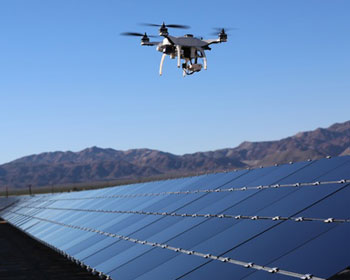Drones are quickly moving beyond the military to a variety of uses. We’ve all heard about Amazon’s plans to deliver packages via drones, but there are much more important, beneficial uses.
Energy could become a prime industry, and SolarCity and First Solar are among those testing drones made by Google-backed Skycatch.
Founded just a year ago, a variety of companies are interested in its drones. Outfitted with a high-resolution camera and other sensors, it keeps watch from the air: inspecting smokestacks and pipelines; monitoring power lines, checking for defects in wind turbines and malfunctioning solar panels, reports the NY Times.
Skycatch drone:

Drones from Canada-based Aeryon Labs search for cracks in wind turbine blades and scan some of BP’s Alaska pipelines for indications of structural weaknesses.
Basically, they provide a safe, inexpensive alternative to human eyes and hands in a wide range of situations that would either be tedious jobs for humans or put them in harms way.
In solar, for example, a drone can easily pick out a broken or malfunctioning solar panel from a field of thousands. A defective panel creates a distinctive heat signal as it fails, Damien Scott, VP of Engineering for SolarCity, explains. "Right now, employees would have to make their way around a large installation using hand-held devices," he told the NY Times.
But a drone outfitted with a thermal sensor can easily find it among the 5.2 million solar PV panels covering 10 square miles at the newly operating Agua Caliente – which First Solar is in charge of maintaining. They fly low over the solar arrays at speeds up to 50 miles per hour.
They can also help before projects are built by scoping out endangered species. Instead of spending millions of dollars for humans to scout for desert tortoises, for instance, drones can do it quickly and cheaply. They can also alert people when an endangered animal wanders into a site, so they can remove it before it’s hurt, reports Toddy Woody in The Atlantic.
They can also help ward off birds, bats and other endangered species from flying near wind and solar farms.
Other beneficial uses:
- stopping poachers before they kill elephants and rhinos in Africa
- to enforce a fishing ban in Palau
- to track where an oil spill is likely to travel
These small, battery-operated drones are becoming increasingly available because of inexpensive 3-D printing, open-source software and cloud computing, says the NY Times.
Skycatch is also bringing down the price through its entirely autonomous process. After its work is complete, a drone flies itself home guided by its camera, sensors and GPS. After landing, a robotic arm switches out the battery for a charged one and the data it contains is sent to the cloud.
Utilities are also testing drones to help them recover electricity faster after extreme weather events. They can scout for damaged transmission lines in remote areas, for example, that may be flooded or barred by fallen trees. And they can send detailed images of downed utility lines or broken utility poles via computer to utilities.
The FAA is expected to issue regulations for the commercial use of this year.
